Garam Masala – aromatic and easy homemade spice mix for spicing up your delicious Indian recipes. This fragrant spice blend is the best ever, authentic, simple and quick to make. Easy to store and use.
Try it with our popular Indian recipes – Chicken Korma and Kofta Curry.
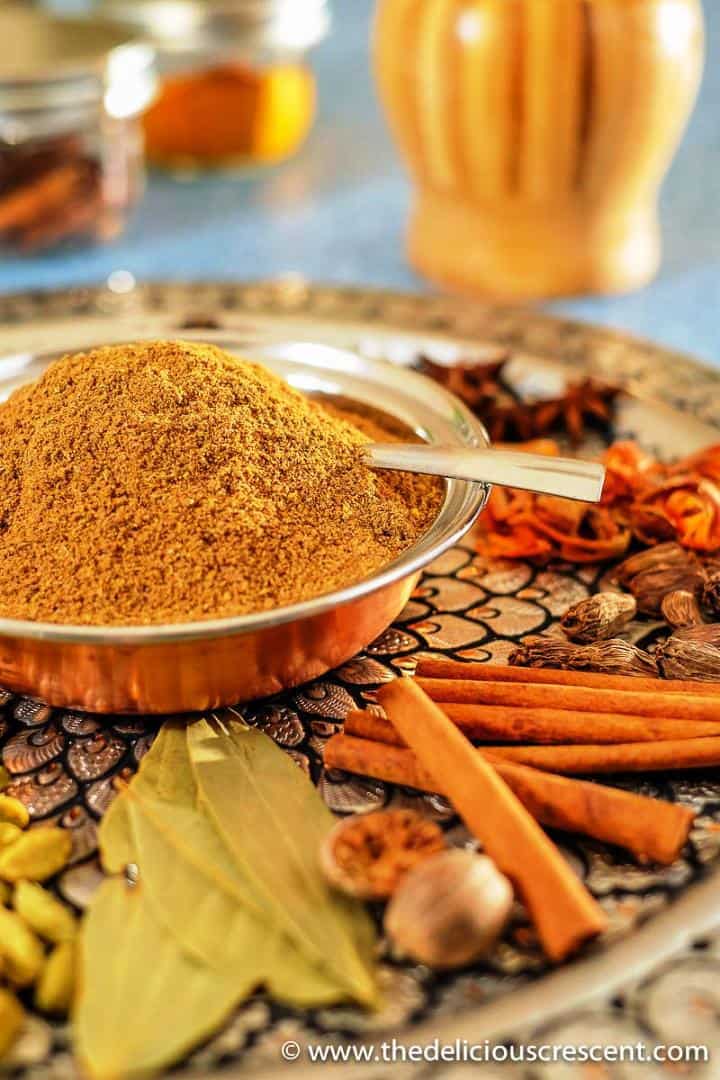
What is Garam Masala?
Garam masala is an aromatic Indian mixture that typically includes spices that are supposed to heat the body. "Garam" means hot and "masala" means spice mixture.
The heat producing spices usually include cardamom, cinnamon, cloves, black cumin, black pepper, nutmeg etc. Traditionally, only small amounts of the spice mix were used to flavor a dish.
Commercialization and a mass appeal to non-Indian communities has led to an evolution of garam masala to include more of the milder spices, such as coriander and cumin. The latter spices are cheaper and therefore used in larger quantities to make the ready-made garam masala mixes, making them less desirable than the homemade versions.
Even if you were to use more coriander, cumin etc., in a homemade blend, it will absolutely taste more delicious than most commercial spice blends.
Here, I share with you an authentic recipe that you will love. Milder spice blends that may also interest you are advieh (Persian spice mix) and baharat spice (middle eastern blend).
How to Make It
This outlines the steps to make an authentic and flavorful garam masala.
- Clean and measure whole spices.
- Toast the spices in a skillet until you smell a nice aroma.
- Let the spices cool completely.
- Grind them until fine, using a nut or spice grinder. Pass through a sieve, if needed, and repeat grinding.
- Alternatively, you can skip toasting the spices, for a more mellow flavor.
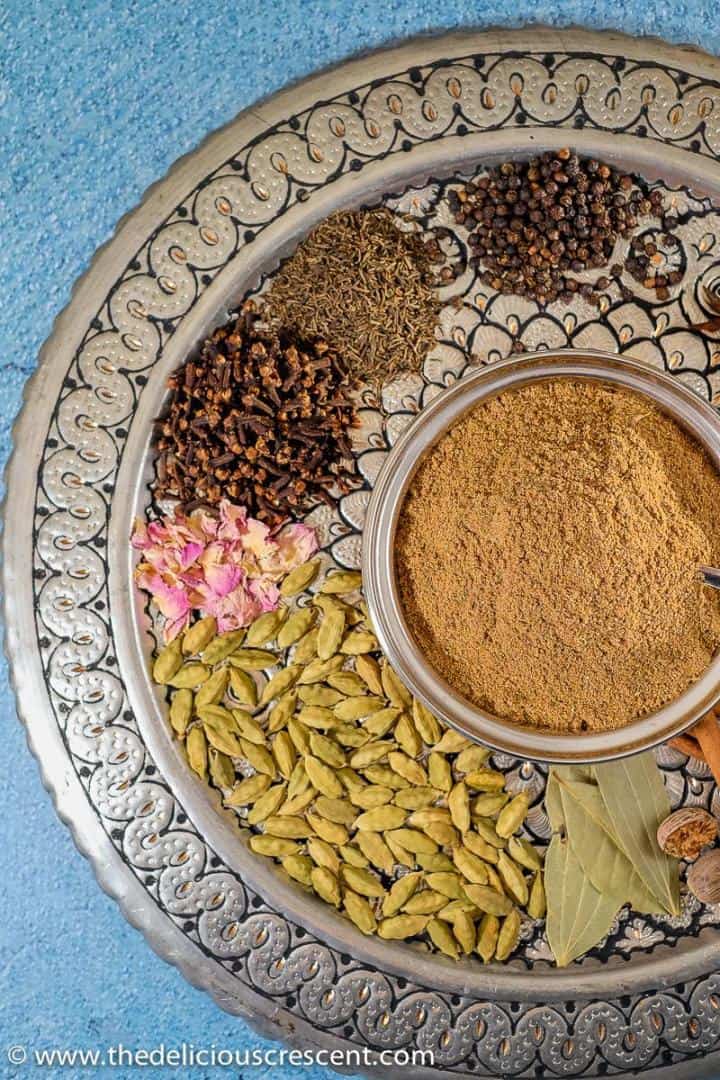
Pro Tips and Tricks
- This recipe will give you a garam masala that is intense. Use smaller amounts for vegetarian recipes.
- If you want a slightly milder version that is perfect for vegetarian recipes, you can make the garam masala using ½ cup coriander seeds, ¼ cup cumin seeds, and 2 tablespoons dried rose petals (optional), instead of the quantities mentioned in the recipe. You may add 1 tablespoon fennel seeds and skip star anise.
- If you don't have black cardamom or black cumin (sometimes referred to as black caraway), just substitute with green cardamom and regular cumin respectively. Black cumin (shahjeera) is quite different than regular cumin but that is the best one can do if it is not available. Preferably purchase shajeera at an Indian store to avoid confusion with the English terms used for this spice.
- How to use: Buy small quantities of fresh whole spices at a store with high turnover, where they are not sitting on shelves for long periods. Store ground garam masala in glass containers and seal tightly.
- Where to buy: It is best to buy spices at ethnic or specialty stores where they sell in bulk, such as whole foods. They are often much cheaper at Indian and middle eastern stores.
- Dried rose petals (culinary grade) are available at Persian/ middle eastern/other ethnic grocery stores or online.
Ingredients and Health Benefits
The common ingredients include cardamom, cloves, cinnamon, coriander, cumin, black pepper, nutmeg and such. And there are numerous variations of traditional garam masala recipes. Some that include black cumin, black cardamom, mace, star anise, fennel etc.
Spices greatly enhance the taste of recipes and offer a lot of health benefits. They are rich sources of antioxidants, polyphenols and other health promoting phytonutrients.
Cardamom: This aromatic spice has been said to improve digestion and circulation, lower blood pressure and fight inflammation. And it also provides some vitamins and minerals.
Cumin: In traditional medicine, cumin is well known for its aid in digestion. It is also supposed to possess anti-oxidant, anti-inflammatory, and carminative properties.
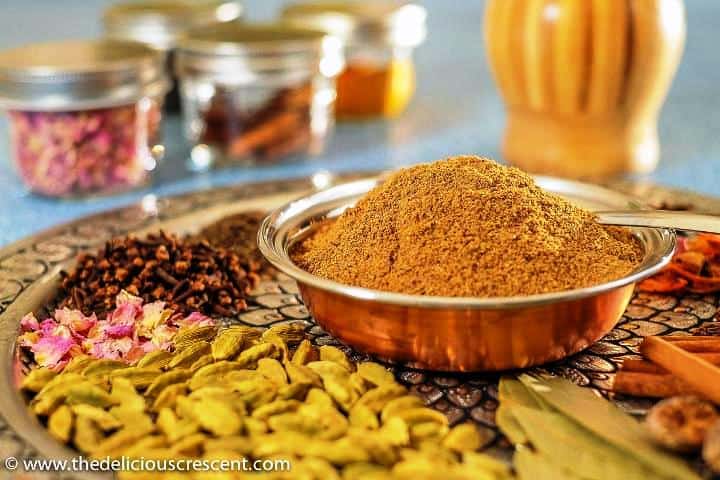
Cinnamon: Obtained from the bark of a tropical tree, cinnamon is considered to have one of the highest antioxidant values for a spice. It has been credited with reducing inflammation and blood triglyceride levels. And is known for lowering blood sugar by enhancing sensitivity to insulin.
Cloves: Known for anti-microbial properties, this spice is especially valued for fighting oral diseases. The benefits associated with cloves include enhancing the immune system, cancer prevention, and maintenance of bone health.
Nutmeg: This is a highly valued spice, known for its aromatic and curative properties since ancient times. The benefits include decreased inflammation, pain relief, boosting of brain health, better sleep, improved digestion, lowering of blood pressure, support of heart health. Provides small amounts of macronutrients, fiber, vitamins, minerals and some phytonutrients.
Coriander: In traditional medicine, this spice has been used to relieve gastrointestinal problems, in addition to being used as an antibiotic and treatment for respiratory ailments, loss of memory and appetite. Some research indicates potential antioxidant, antimicrobial, neurological and diabetes modulating benefits, with further study recommended.
Black Pepper: Black pepper is supposed to have anti-inflammatory, carminative, digestive, cardioprotective and anti-oxidant properties.
Dried Rose Petals: The rose petals used for culinary purposes are obtained from a wild variety of rose. Rich in phytochemicals, rose petals lend a fragrant floral note and can balance the warm spices used in savory dishes.
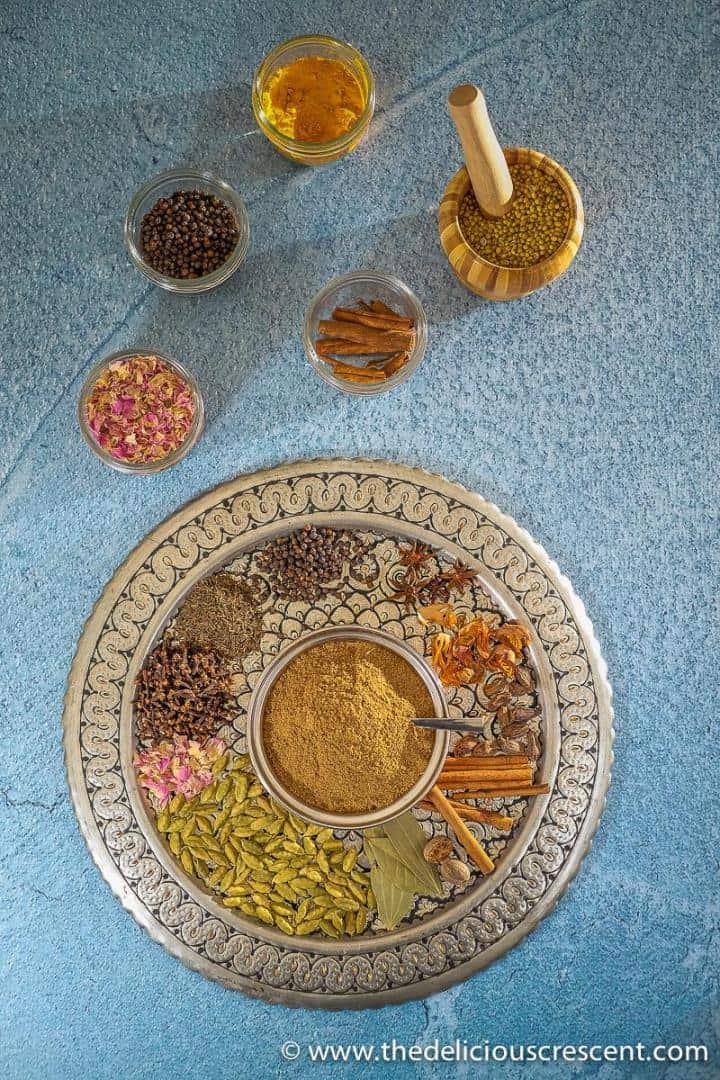
FAQs
It is best to make this blend in smaller quantities based on your usage. If you don't cook Indian food often, just scale down the recipe.
Garam masala is more aromatic, richer and sweeter in flavor than curry powder, as it includes cardamom, cinnamon, nutmeg etc. Whereas, the predominant spices in curry powders are turmeric, coriander and such. Garam masala does not traditionally include turmeric. Curry powders cannot effectively substitute for garam masala in making the famous Indian recipes, such as butter chicken, korma, saag paneer and so on.
There is really no good substitute for garam masala. Any other spice blend from other eastern cuisines or the curry powders are not going to taste the same.
I would not advise buying most ready-made garam masala brands. They use cheaper spices and are less aromatic. Besides, they are not made from fresh whole spices, so will not flavor your Indian dishes like this homemade recipe. Most importantly, it will be hard to control the degree of pungency and salt in your preparations, because store bought blends may have too much chili powder and/or salt.
More Indian Recipes:
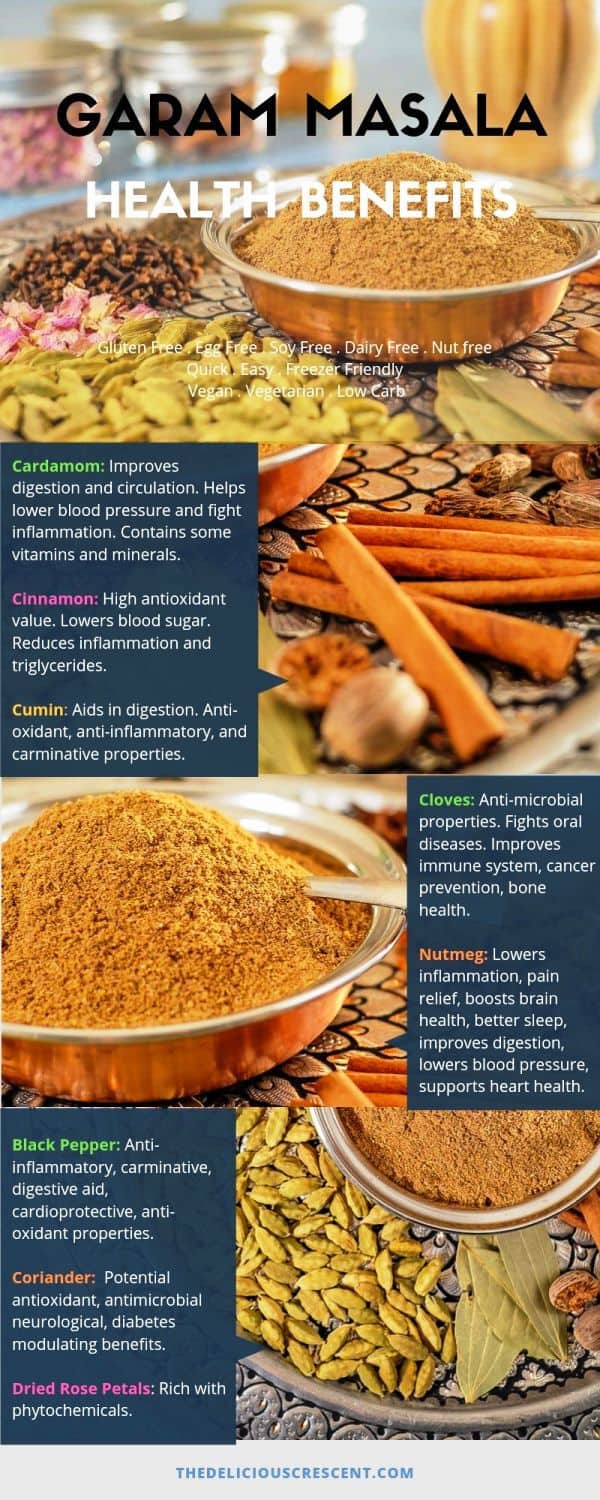
Share this Image On Your Site
★ DID YOU MAKE THIS RECIPE? PLEASE COMMENT AND GIVE IT A STAR RATING BELOW!
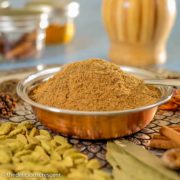
Garam Masala Recipe
Ingredients
- ⅓ cup coriander seeds
- 3 tablespoons cumin seeds
- 3 tablespoons green cardamom
- 2 tablespoons cloves
- 1 tablespoon black peppercorns
- 4 sticks ground cinnamon 12 inches total
- 3 black cardamom see note
- 2 teaspoons shah Jeera shahjeera, see note
- 3 bay leaves
- ¼ whole nutmeg small seed
- 2 blades mace
Optional Ingredients
- ¼ cup rose petals dried
- 1 star anise
Equipment
- Spice/Nut Grinder
- Measuring Spoons
- Measuring Cups
- Glass Spice Containers
Instructions
- Check to make sure the spices are clean and do not have any extraneous substances.
- Measure out the whole spices.
- Toast the spices at low setting, in a skillet (preferably cast iron) for more intense flavors. Start with the larger spices (cardamom, cinnamon....). After couple minutes of toasting them, add the smaller spices (coriander, cumin, black pepper....). Toast until you smell a nice aroma, but don't burn them.
- Allow the spices to cool completely.
- Transfer to a nut or spice grinder and grind them until fine. Pass through a sieve, if necessary and repeat grinding down the coarse mixture.
- Alternatively, you can completely skip the toasting for a more mellow flavor.
- Do not toast the rose petals, if using them.
- Store spice mixes in glass spice containers.
Notes
- The recipe here is quite intense and works best for meats, chicken and such. And use smaller amounts for vegetarian recipes.
- If you want a slightly milder version that is perfect for vegetarian recipes, you may make the garam masala using ½ cup coriander seeds, ¼ cup cumin seeds, and 2 tablespoons dried rose petals (optional) instead of the quantities mentioned in the recipe above. You may use 1 tablespoon fennel seeds and skip star anise.
- If you don't have black cardamom or black cumin, just substitute with green cardamom and regular cumin respectively. Black cumin (shahjeera) is quite different than regular cumin but that is the best one can do if it is not available. Preferably purchase shahjeera at an Indian store to avoid confusion with the English terms used for this spice.
- How to use: Buy fresh whole spices and in small quantities at a store with high turnover, where they are not sitting on shelves for long periods. Store ground garam masala in glass containers and seal tightly.
- Where to buy: It is best to buy spices at ethnic or spice specialty stores where they sell in bulk, such as whole foods. They are often much cheaper at Indian and middle eastern stores.
- Substitute for Garam Masala: There is really no good substitute for garam masala. Any other spice blend from other eastern cuisines or curry powders are not going to taste the same.
- Dried rose petals (culinary grade) are available at Persian/ middle eastern/other ethnic grocery stores or online.


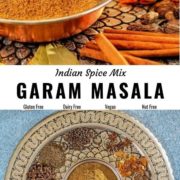
Brandon
Just wondering what variety of rose petal you would be using for this Garam masala? Would it happen to be damask rose?
Roxana Begum
Culinary grade rose petals. There are several varieties, the one you mention is one of them.
Amynah
Can you give a recipe to show exactly how your garam masala is used?
Roxana Begum
On the blog some recipes that use garam masala are egg curry, kofta curry, aloo gobi etc.
Alonna Smith
Hi Roxana,
I love your website and all the details you've included in this post! As I am sure you know, each area of India has their preferred spice blend and ratios of those spices. Would you say your blend is more traditional in one state or region? Thanks!
Roxana Begum
Thanks Alonna. This garam masala flavor profile is not specific to a particular state. There are other Indian spice blends that may be more regional. Garam masala is typically used in Mughlai and north Indian dishes.
Century Foods
Garam masala the best spice ever. Thanks for such a lovely article. Really informative and useful.
Meadow SB
Hi Roxana, Good day.
Just wanted to clarify about measuring green cardamom. You have indicated 3 tbsp of green cardamom in the ingredient list. Are they whole pods, or, seeds extracted from pods?
Roxana Begum
Whole Pods.
Daniel
When you say 3 black cardamom, do you mean three pieces, or three tablespoons as for the green variety? Thanks, just starting to make it now.
Roxana Begum
Just three pieces.
Brian Gilbert
Do you put chilli in garam masalla?
Roxana Begum
No I dont. That way I find it easier to use garam masala for all dishes by adding chili powder as per taste.
Raiko
I can't wait to try this recipe someday! Thanks a lot for sharing this!
Matt Ivan
I found homemade spices can be much better than store-bought mixes. This one looks so rich and flavorful!
Roxana Begum
Thanks Matt.
Demeter
Such a fantastic idea to make your own spice blends. Love that you really get to know what it's made of and able to customize it to your own liking. Thanks!
Roxana Begum
Absolutely. So glad you like it :)
Abigail S. Raines
I love making curry dishes and often use garam masala to finish it off. My favorite spice!
Natalie
Thank you for sharing this. I always buy garam masala in store but I bet this homemade version is way better. This sounds easy to make so I'll definitely give it a try. Bet my family will be delighted with this new spice mix.
Roxana Begum
Thanks for your lovely feedback Natalie. This will taste much better. More flavorful.
Andrea Metlika
I really appreciate all the information about the different spices that you gave.